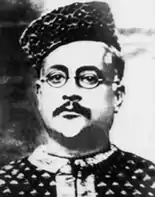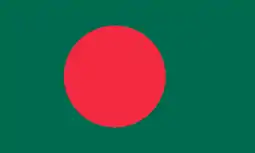Dhakaiya Urdu
Dhakaiya Urdu (Urdu: ڈھاکیہ اُردُو, romanized: dhākāyā urdū, lit. 'Urdu of Dhaka'), also known Khosbas Dhakaiya (Urdu: خوشباس ڈھاکایہ, romanized: Khūshbās Dhākāyā), is a dialect of Urdu native to Old Dhaka and its surrounding areas in Bangladesh. It is spoken by the city's Khusbas community and the erstwhile Nawab family of Dhaka. The usage of the language is gradually declining due to negative perceptions following the Bengali Language Movement as well as it not being given an official status.[1][2] Dhakaiya Urdu is one of the two dialects of Urdu spoken in Bangladesh; the other one being the Urdu spoken by the Biharis and Stranded Pakistanis in Bangladesh.
| Dhakaiya Urdu | |
|---|---|
| Region | Old Dhaka |
| Era | 16th century-present |
| Language codes | |
| ISO 639-3 | – |

Features
The dialect differs from Standard Urdu as it takes a number of loanwords from the Bengali language, which the dialect's source of origin is geographically surrounded by. The intonations and tone of the language is also shifted closer to Bengali than Standard Urdu. It is described to be a fairly simpler language than Standard Urdu.[1]
History
During the Mughal era, the Bengal Subah was famed for being the wealthiest and industrially the most developed place in the world and having waved the proto-industrialization, its economy showed signs of Industrial revolution.[3] The city of Jahangirnagar (now Dhaka) was the province's capital in the mid-eighteenth century and Urdu-speaking merchants from North India started pouring in. Eventually residing in Dhaka, interactions and relationships with their Bengali counterparts led to the birth of a new Bengali-influenced dialect of Urdu.[4] The descendants of these settlers came to be known as Khusbas (other names included Sukhbas and Subbasi) which meant the happily settled. The Bais and Bara panchayets, as well as the Nawabs of Dhaka, used to converse in this language.[5] Their Urdu language also influenced the language of the Bengali Muslims in Old Dhaka which came to be known as the Dhakaiya Kutti language.[6]
Shortly after the Bengali Language Movement of 1952, Urdu culture decreased significantly with many Urdu-speaking families switching to speaking Bengali to avoid controversy. During the Bangladesh Liberation War of 1971, a number of Urdu-speaking families subsequently migrated to Pakistan. As a result, the use of Urdu has become very limited to a few families and a community south of the Dhaka railway line. Furthermore, the new nation of Bangladesh deemed their newly founded nation on Bengali culture, which would later alienate the other ethnolinguistic communities of the country.
Often described as a wealthy and closed-off community, speakers of the dialect honor the Dhakaiya Urdu poets of the past in privacy within their mushairas. Other modern examples of usage include the University of Dhaka's dwindling Urdu department as well as the Urdu sermons and Islamic lectures given in Dhaka.[7][1]
Literature and media
| Part of a series on the |
| Culture of Bangladesh |
|---|
 |
| History |
| Traditions |
| Religion |
| Sport |
|
The late 18th-century in Dhaka hosted the migration of Mirza Jan Tapish and other Urdu poets from Delhi migrating to the urban hub after an invitation from Shams ad-Daulah, the Naib Nazim of Dhaka.
Poetry and literature in Urdu grew popularity in Dhaka with the presence of organisations such as the Anjuman-i Taraqqi-i Urdu and the patronising of it by Dhaka's Nawabs, Sardars and Zamindars such as Khwaja Abdul Ghani and Mir Ashraf Ali. The 19th-century poet Mirza Ghalib of Agra was a close friend of Dhaka's poet Khwaja Haider Jan Shayek. The collaboration between Ghalib and Shayek was collected and compiled by Hakim Habibur Rahman, a later Urdu poet of Dhaka, in his book Inshaye Shayek. Habibur Rahman was a prominent Dhakaiya physician and litterateur whose most famous books include Asudegan-e-Dhaka and Dhaka Panchas Baras Pahle. He was the editor of Bengal's first Urdu magazine, Al-Mashriq in 1906. He later collaborated with Khwaja Adil in 1924 to found another monthly journal called Jadu. His works are celebrated for preserving Urdu, Persian and Arabic literature, compiling them into his Thulatha Ghusala.[8]
The language flourished in the media during the 20th century cinema. Khurshid Alam and Sabina Yasmin sang a song, Matiya Hamar Naam, in this dialect for the Bangladeshi film Jibon Niye Jua which released in 1975 after the Independence of Bangladesh.
Poets
- Mirza Jan Tapish (d. 1814)
- Khan Bahadur Abdul Ghafur Nassakh
- Mahmud Azad
- Ghaffar Akhtar
- Agha Ahmad Ali Isfahani (1839-1883)
- Maulana Ubaidullah Al-Ubaidi Suhrawardy (1834-1885)
- Munshi Rahman Ali Tayesh (1823-1908)
- Nawab Syed Muhammad Azad (1850-1916)
- Hakim Habibur Rahman (1881-1947)
- Syed Sharfuddin Sharf Al-Hossaini (1876-1960)
- Reza Ali Wahshat (1881-1953)
See also
References
- Huda, Sarah Elma (16 March 2019). "Between two languages: Examining my identity as a Bangladeshi". The Daily Star (Bangladesh).
- Ahmad Hasan Dani (1962). Dacca: a record of its changing fortunes. Mrs. S. S. Dani. p. 159.
- Lex Heerma van Voss; Els Hiemstra-Kuperus; Elise van Nederveen Meerkerk (2010). "The Long Globalization and Textile Producers in India". The Ashgate Companion to the History of Textile Workers, 1650–2000. Ashgate Publishing. p. 255. ISBN 9780754664284.
- ঢাকাইয়া কুট্টি ভাষার অভিধান-মোশাররফ হোসেন ভূঞা-প্রকাশনা: ঐতিহ্য-রুমী মার্কেট ৬৮-৬৯ প্যারীদাস রোড-বাংলাবাজার ঢাকা ১১০০
- Mamoon, Muntassir (2012). "Panchayet System, Dhaka". In Islam, Sirajul; Miah, Sajahan; Khanam, Mahfuza; Ahmed, Sabbir (eds.). Banglapedia: the National Encyclopedia of Bangladesh (Online ed.). Dhaka, Bangladesh: Banglapedia Trust, Asiatic Society of Bangladesh. ISBN 984-32-0576-6. OCLC 52727562. Retrieved 7 February 2021.
- Prof. Dr. Hafiza Khatun (17 January 2017). Dhakaiyas and Gentrification in Old Dhaka (PDF). Asiatic Society of Bangladesh. p. 4.
- Gilbert, Paul Robert (September 2015). "Re-branding Bangladesh: The Other Asian Tiger". Money mines: an ethnography of frontiers, capital and extractive industries in London and Bangladesh (Thesis). University of Sussex.
- "Urdu in Bangladesh". Dawn. 11 September 2002.
Further reading
- Kaniz-e-Butool (2012). "Urdu". In Islam, Sirajul; Miah, Sajahan; Khanam, Mahfuza; Ahmed, Sabbir (eds.). Banglapedia: the National Encyclopedia of Bangladesh (Online ed.). Dhaka, Bangladesh: Banglapedia Trust, Asiatic Society of Bangladesh. ISBN 984-32-0576-6. OCLC 52727562. Retrieved 7 February 2021.
- Wafa Rashedi, Bangal Mein Urdu, Hyderabad, Pakistan (1955)
- TG Baily, A History of Urdu Literature
- Rambabu Saxsina, History of Urdu Literature, Lucknow.